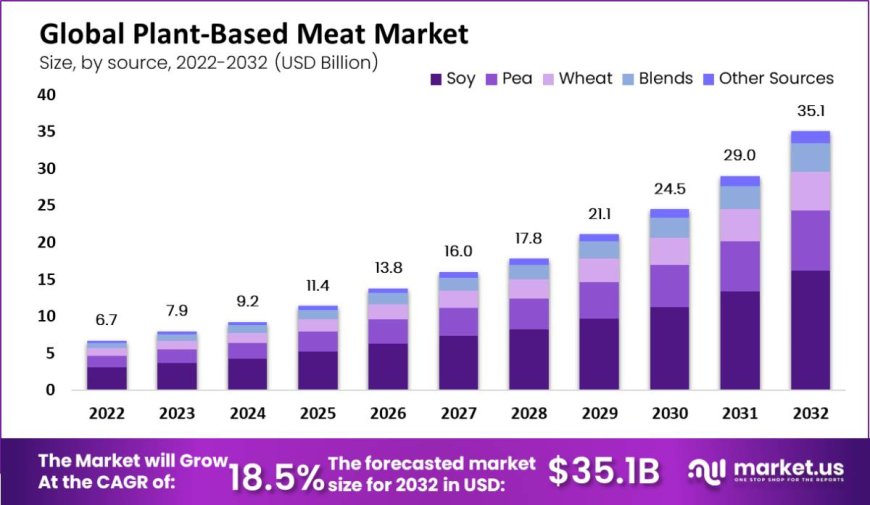Plant Based Meat Consumer Preference for Low-Fat Alternatives Drives
Plant-Based Meat Market by Source (Soy, Pea, Wheat, Blends, And Other Sources), By Meat Type (Chicken, Pork, Beef, Fish, and Other Meat Types), By Product Type (Burgers, Patties, Sausages, Other Product Types), By End-User, By Region and Companies - Industry Segment Outlook, Market Assessment, Competition Scenario, Trends, and Forecast 2023-2032

Plant-Based Meat Market size was valued at USD 6.7 billion and will reach USD 35.1 billion by 2032. Between 2023 and 2032, this market is estimated to register the highest CAGR of 18.5%
Plant-based meat refers to products that mimic the taste, texture, and appearance of traditional animal meat but are entirely derived from plant sources such as wheat, pulses, and soy. These alternatives are designed to provide a meat-like experience while offering health benefits associated with plant-based diets..
The shift towards plant-based meats is driven by growing concerns about personal health and environmental sustainability.
With added benefits such as antioxidants, minerals, and vitamins, plant-based meat products offer a nutritious alternative that supports both individual health goals and broader environmental conservation efforts.
The plant-based meat market is seeing significant growth, driven by the dominance of soy-based meat, which accounted for 46% of global revenue in 2022 due to its nutritional benefits and low environmental impact. Pea-based meat is also expanding rapidly. Plant-based chicken holds the largest market share by meat type, while burger patties are the leading product category. The frozen segment dominates storage methods, and the HoReCa sector leads among end-users, driven by rising vegan food trends in restaurants and hotels.
Key Market Segments
By Source
-
Soy
-
Pea
-
Wheat
-
Blends
-
Other Sources
By Meat Type
-
Chicken
-
Pork
-
Beef
-
Fish
-
Other Meat Types
By Product Type
-
Burger Patties
-
Sausages
-
Strips & Nuggets
-
Meatballs
-
Other Product Types
By Storage
-
Refrigerated
-
Frozen
-
Shelf-Stable
By End-User
-
HoReCa
-
Food Industry
-
Households
Download a sample report in MINUTES@ https://market.us/report/plant-based-meat-market/#requestSample
Market Key Players
-
Beyond Meat Inc.
-
Impossible Foods Inc.
-
Maple Leaf Foods Inc.
-
Vegetarian Butcher
-
Conagra Inc.
-
Kellogg NA Co.
-
Marlow Foods Ltd.
-
Amy’s Kitchen Inc.
-
Tofurky
-
Gold&Green Foods Ltd.
-
Praeger’s Sensible Foods
-
VBites Foods Ltd.
-
LikeMeat GmbH
-
Lightlife Foods Inc.
-
Trader Joe’s
-
The Hain-Celestial Canada ULC
-
Marlow Foods Ltd.
-
Ojah B.V.
-
Eat Just Inc.
-
No Evil Foods
-
Other Key Players
Driver: Increasing consumer preference for vegan diets and plant-based meat products is driven by health consciousness and environmental concerns, driving market growth. The availability of diverse plant-based meat options, including soy-based products, is further fueling demand, especially among athletes and health-conscious individuals.
Restraint: High processing levels and added sodium content in plant-based meat products diminish their nutritional value compared to traditional meats, posing health risks such as elevated blood pressure. Additionally, the higher cost and lack of essential nutrients like omega-3 fatty acids restrain market expansion.
Opportunity: Growing awareness and government initiatives promoting animal welfare are creating lucrative opportunities for plant-based meat products. Manufacturers focusing on improving nutritional profiles and expanding product offerings are expected to capitalize on increasing consumer demand and the rising popularity of flexitarian diets.
Challenge: Despite the health benefits, concerns about the nutritional adequacy and processing of plant-based meats remain challenges for market acceptance and sustained growth. Meeting diverse consumer expectations while maintaining product integrity and nutritional value presents ongoing challenges for the industry.












